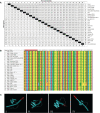A highly efficient indirect ELISA and monoclonal antibody established against African swine fever virus pK205R
- PMID: 36700212
- PMCID: PMC9868132
- DOI: 10.3389/fimmu.2022.1103166
A highly efficient indirect ELISA and monoclonal antibody established against African swine fever virus pK205R
Abstract
African swine fever (ASF) is a contagious infectious disease with high lethality which continuously threatens the global pig industry causing huge economic losses. Currently, there are no commercially available vaccines or antiviral drugs that can effectively control ASF. The pathogen of ASF, ASF virus (ASFV) is a double-stranded DNA virus with a genome ranging from 170 to 193 kb and 151 to 167 open reading frames in various strains, which encodes 150-200 proteins. An effective method of monitoring ASFV antibodies, and specific antibodies against ASFV to promote the development of prevention techniques are urgently needed. In the present study, pK205R of ASFV was successfully expressed in mammalian cells using a suspension culture system. An indirect enzyme-linked immunosorbent assay (ELISA) based on the purified pK205R was established and optimized. The monoclonal antibody (mAb) against pK205R recognized a conservative linear epitope (2VEPREQFFQDLLSAV16) and exhibited specific reactivity, which was conducive to the identification of the recombinant porcine reproductive and respiratory syndrome virus (PRRSV) expressing pK205R. The ELISA method efficiently detected clinical ASFV infection and revealed good application prospects in monitoring the antibody level in vivo for recombinant PRRSV live vector virus expressing the ASFV antigen protein. The determination of the conserved linear epitope of pK205R would contribute to further research on the structural biology and function of pK205R. The indirect ELISA method and mAb against ASFV pK205R revealed efficient detection and promising application prospects, making them ideal for epidemiological surveillance and vaccine research on ASF.
Keywords: 293i cells; ASFV pK205R; epitope; indirect ELISA; recombinant PRRSV.
Copyright © 2023 Li, Qiao, Liu, Zhou, Tong, Dong, Liu, Jiang, Guo, Zheng, Zhao, Tong, Li and Gao.
Conflict of interest statement
The authors declare that the research was conducted in the absence of any commercial or financial relationships that could be construed as a potential conflict of interest.
Figures







Similar articles
-
The Indirect ELISA and Monoclonal Antibody against African Swine Fever Virus p17 Revealed Efficient Detection and Application Prospects.Viruses. 2022 Dec 23;15(1):50. doi: 10.3390/v15010050. Viruses. 2022. PMID: 36680090 Free PMC article.
-
Epitope mapping and establishment of a blocking ELISA for mAb targeting the p72 protein of African swine fever virus.Appl Microbiol Biotechnol. 2024 May 29;108(1):350. doi: 10.1007/s00253-024-13146-x. Appl Microbiol Biotechnol. 2024. PMID: 38809284 Free PMC article.
-
Identification of a conservative site in the African swine fever virus p54 protein and its preliminary application in a serological assay.J Vet Sci. 2022 Jul;23(4):e55. doi: 10.4142/jvs.21134. Epub 2022 May 16. J Vet Sci. 2022. PMID: 35698809 Free PMC article.
-
Structure of African Swine Fever Virus and Associated Molecular Mechanisms Underlying Infection and Immunosuppression: A Review.Front Immunol. 2021 Sep 6;12:715582. doi: 10.3389/fimmu.2021.715582. eCollection 2021. Front Immunol. 2021. PMID: 34552586 Free PMC article. Review.
-
Research progress on the proteins involved in African swine fever virus infection and replication.Front Immunol. 2022 Jul 22;13:947180. doi: 10.3389/fimmu.2022.947180. eCollection 2022. Front Immunol. 2022. PMID: 35935977 Free PMC article. Review.
Cited by
-
Novel Epitope Mapping of African Swine Fever Virus pI215L Protein Using Monoclonal Antibodies.Viruses. 2023 Oct 12;15(10):2081. doi: 10.3390/v15102081. Viruses. 2023. PMID: 37896858 Free PMC article.
-
The Novel Antigenic Epitopes of African Swine Fever Virus Inner Membrane p54 Protein Revealed by Monoclonal Antibodies.Animals (Basel). 2025 Apr 30;15(9):1296. doi: 10.3390/ani15091296. Animals (Basel). 2025. PMID: 40362108 Free PMC article.
-
Developing an Indirect ELISA for the Detection of African Swine Fever Virus Antibodies Using a Tag-Free p15 Protein Antigen.Viruses. 2023 Sep 16;15(9):1939. doi: 10.3390/v15091939. Viruses. 2023. PMID: 37766344 Free PMC article.
-
Develop an indirect ELISA utilizing gD protein to detect antibodies against bovine herpesvirus type 1.Front Cell Infect Microbiol. 2025 May 8;15:1591304. doi: 10.3389/fcimb.2025.1591304. eCollection 2025. Front Cell Infect Microbiol. 2025. PMID: 40406523 Free PMC article.
-
Epitope mapping targeting the K205R protein of African swine fever virus using nanobody as a novel tool.Microbiol Spectr. 2025 May 6;13(5):e0175024. doi: 10.1128/spectrum.01750-24. Epub 2025 Apr 2. Microbiol Spectr. 2025. PMID: 40172217 Free PMC article.
References
Publication types
MeSH terms
Substances
LinkOut - more resources
Full Text Sources
Other Literature Sources

